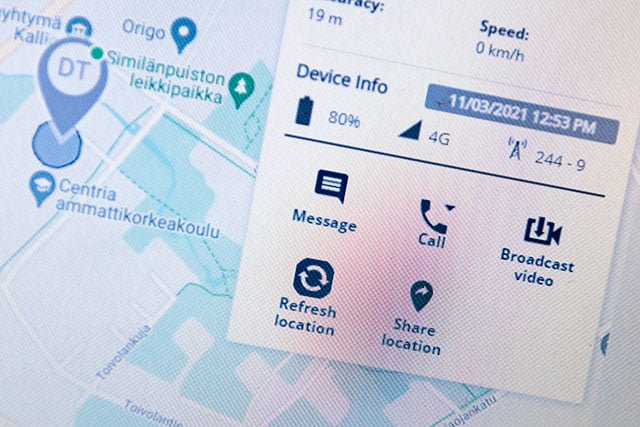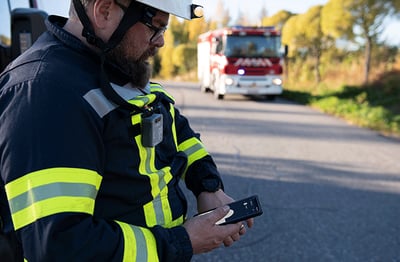Critical communications continue to migrate to broadband, and the pace is getting quicker. How should you go about adopting broadband capabilities? And how can you make sure that your TETRA to 4G/5G migration project is a success?
Think about your current radio communication system. Whether it covers a limited area or spans an entire country, it is critical to your operations. Professionals use their radios as a lifeline.
Now think about switching from that system to a new one that works on a different technology. A TETRA to 4G/5G migration project is exactly that. It will be a huge undertaking, and it will only succeed when the users’ operational needs are at the core of the plan, from start to finish.
There are more things to consider when planning a broadband migration. These are the 14 ways to make a TETRA to 4G/5G migration project easier and more manageable and achieve results that can keep users happy.
1. Look beyond technology
2. Engage and empower the users
3. Focus on user needs and use cases
4. Make sure users can continue working as normal
5. Recognize the huge dimensions of the migration project
6. Check what the migration budget covers
7. Break down the project into phases and steps
8. Introduce this major change first – it’s challenging enough
9. Think about new capabilities
10. Don’t worry about what isn’t possible yet
11. Plan to migrate the control rooms, dispatching, and narrowband applications
12. Consider the Inter-System-Interface!
13. Do not forget the provisioning
14. Save money during migration
1. Look beyond technology
When discussing TETRA migration, there is a lot of talk of broadband technologies and interfaces. This approach includes a serious risk – that the users’ point of view might be neglected. In fact, forgetting the users will lead to several risks.
Migrating from TETRA to 4G/5G broadband will be a demanding project. It will take years, and it requires proper planning. During the migration period, operations must continue without any breaks or service level deviations. This is particularly important in public safety and other critical organizations. This is why the users’ needs must drive the planning.
Considering only the mission-critical push-to-talk (MCPTT) will not be enough. There is more to critical communications of the future. The new technology for push-to-talk isn’t the whole deal. Users’ needs must be discussed and considered more than the technology.
2. Engage and empower the users
The move from TETRA to broadband means significant changes that affect many people. There needs to be a structured way to engage people in these changes.
First responders and other professionals will not adopt new communication solutions without thoroughly verifying them. If something doesn’t work right during a mission, the risk is not to money, but to lives.
User acceptance is critical. Users will need to contribute strongly to the TETRA to 4G/5G broadband migration. Their contribution and insight are valuable when mapping the operational needs and real-life use cases to the new communications technology.
The migration project must ensure that the adoption of broadband services and smart devices is a smooth process for the users. When they can communicate seamlessly no matter which technology their colleagues use, they will have little reason to resist the change.

3. Focus on user needs and use cases
The migration project must understand the different needs for functionalities and schedules that different user organizations have. User organizations can also define speed at which new services are adopted.
Users should be able to concentrate on their own needs without considering which technology will be used.
Let’s take just one example – the capacity of the interface between TETRA and the MCX (where the X refers to push-to-talk, video, and data) systems. In technical terms, this may be a question of capacity or functionality.
But before trying to answer that question, we must recognize the real questions: “How many subscribers and talk groups need to communicate together in the TETRA and MCX systems and which services they need to use between the two systems?”
In other words, the technical implementation must meet the users’ operational needs. This is true customer-centricity and one of the key guarantees of a successful migration project.
4. Make sure users can continue working as normal
User organizations want to continue with the communication services they are accustomed to, because the services meet their operational needs. The migration project will make a mistake if it offers user organizations a new service that fails to deliver the key communication services and functionalities.
Instead, the migration project should make sure that adopting broadband services and smart devices is a smooth process for the user organizations. The users’ critical communication services must not be disturbed.
Take a field operation of the police during migration – what if an officer were calling for backup and instead received the message “illegal operation, contact your IT administrator”?

In other words, organizations should not have to adjust the way they work when they first move to broadband. Users are accustomed to TETRA communication functionalities and expect their communications on smart devices to work in the same way. They also expect to continue to communicate seamlessly during migration, no matter which technology their colleagues use - TETRA or broadband.
Broadband devices and TETRA radios must be able to work together seamlessly. Users also need to communicate with command centers, dispatchers, and applications integrated into TETRA.
This brings up the next success factor.
5. Recognize the huge dimensions of the migration project
The migration will be a significant undertaking even for a smaller TETRA system, let alone for a nationwide network. It resembles a massive construction project, with its numerous stakeholders, solution providers, participants, and schedules.
There is also no generic migration template to follow - every case is different. There are many open questions when interconnecting TETRA and MCX solutions, and the needs and requirements can vary. The migration period can be longer or shorter.
There are differences and special requirements for Command-and-Control room interoperability, as well as dispatcher interoperability. The organizations’ own applications integrated into TETRA will have to be migrated, too.
The provisioning solutions for organizations, groups and subscribers can also be wildly different.
The migration project is complex and extensive. Changes, adjustments, and even surprises are inevitable, so the plan must be flexible.
And this brings us to success factor number six.
6. Check what the migration budget covers
The broadband migration project needs a budget. And this is where user organizations need to be alert. They should make sure that the migration project has all the necessary elements in the scope of the budget.
What if the budget covers only the migration of communications from TETRA to MCX and nothing else?
There would be no money for migrating control rooms, dispatching solutions, emergency response centers, or for the organizations’ own applications.
The result would be failure of the broadband migration project.
Firstly, users would have a hard time communicating with their dispatchers - there may be no smooth connection to the emergency response center. Secondly, the integrated applications would no longer work. These include applications that police or firefighters use every day and rely on without thinking.
The next item will help in defining and getting the necessary budget.
7. Break down the project into phases and steps
How do you eat an elephant?
One small bit at a time.
Similarly, the migration project in all its complexity must be broken down into phases and steps. A stepwise approach has many advantages. It is easier for everyone - it also has lower risks. For example, user organizations will appreciate the stepwise approach because it will be less disruptive to their operations. No user will want to adopt new ways of working overnight!
The phases split the introduction of new technology into manageable parts. Each project should also decide the way to proceed with the migration – whether by organizations, geographical areas, talk groups or users.
The first phase should introduce the broadband connection service. This service should be mission critical to meet the needs of its professional users. Smart devices should also be rolled out in this phase.
Users will expect to communicate using smart devices in the same way as TETRA. The next phase could deliver this, to meet the users’ operational needs.
This phase could also deliver some added value from broadband. This could include multimedia services such as video sharing, solutions for better situational awareness, or new apps that automate repetitive tasks, for example.
The other phases could be dedicated to the migration of control rooms, emergency response centers, and customized applications.
A phased approach is flexible and allows each stakeholder to define the broadband adoption plan that works for them.
Handpicked related content
Watch this webinar recording: "The next 5 things to do immediately about your broadband communications". You will learn about the smart moves to public safety broadband.
8. Introduce this major change first – it’s challenging enough
It’s important for people to have easy-to-use communication tools, particularly in public safety organizations. They need to concentrate on their duties, not on their tools.
Broadband migration means that users will adopt smart devices. They will find it challenging enough to learn to use the new device. They need to use the device and its communication application in a new way. The migration project cannot expect people to start using an unfamiliar device while also communicating and working in a different way. That would be risky.
At the start of the migration, users should be able to continue with communication functions and features that are familiar from TETRA - even when they use smart devices.

9. Think about new capabilities
Why recreate something that already exists and works well? User organizations are concerned about losing TETRA communications. They are afraid that broadband migration will break something that is working very well.
The migration project should not focus on adopting new technology but build something new and helpful for user organizations - something that can only run on top of the new technology.
User organizations are keen to adopt new, practical, and useful tools. They want the new capabilities that broadband can offer. Why not start by serving an unmet need? People will welcome change when you can offer them an extra benefit.

10. Don’t worry about what isn’t possible yet
Many features familiar from TETRA systems will be different in 4G/5G broadband. On the other hand, smart devices and broadband connectivity make it possible to do new things. The MCX standard is new and it evolves: this will encourage changes in the way user organizations work. It is better to develop things in sync with the available features and capabilities, and not try and achieve something that is not yet supported.
The migration project should start from the basics and not get stuck on fine points that are not available yet.
11. Plan to migrate the control rooms, dispatching, and narrowband applications
Migrating control rooms successfully into broadband communications will be a challenge of its own. Bigger communication networks tend to have a large number of different control room and dispatching solutions from different vendors. There is no standard for control rooms, so there are many options for integrating them.
For example, today’s authority networks in Europe have hundreds of control rooms, delivered by dozens of vendors. Every vendor must draw up a plan for each control room. Even in one country, it will not be possible to migrate all control rooms to broadband at the same time.
Most TETRA systems also include integrated data applications – dozens of these are in use, forming an important part of the users’ daily work. It is vital to make these customized applications part of the migration.
Migrating control rooms, dispatching, emergency response centers, and narrowband applications needs new interfaces and integration work. Solution providers will need to make their own migration plans, schedules, and contracts.
The broadband migration project needs to shift the focus from technology, which over-simplifies the issue. If the project gives all its attention to technology, it will certainly fail.
12. Consider the Inter-System-Interface!
Three Nordic countries of Finland, Sweden, and Norway use the Inter-System Interface (ISI) for cross-border cooperation. Users in these three authority networks can work and communicate together across the network borders, as well as actual country borders.
Each of these countries will adopt broadband at their own pace. Making separate plans means the countries do not depend on each other.
The user organizations in the three countries all want the new technology to offer the same ISI functionality as the current one. These means that TETRA-ISI-cooperation groups cannot be taken out of use until all three countries have completed their broadband migration and have the necessary cross-border communication functionalities in use.
13. Do not forget the provisioning
A user may need to communicate in the current radio system and also in the broadband system. For example, a group can include both radio-carrying and smartphone-using members. In this case, the person calling will need to be known by both systems - this user (or subscriber) needs to be provisioned in both systems.
Without a common tool, user organizations will need to provision users, groups, and organizations separately into each network. There is a risk of provisioning something into one system and not into the other one. A universal provisioning tool will eliminate this risk.
14. Save money during migration
Maintaining the existing system alongside a new one might seem like “money wasted.” But a sudden switchover is risky. If the “hard migration project” does not succeed or if there are delays, it may be necessary to prolong the life of the existing system – possibly at huge cost.
The business case for adopting new communications technology must be based on the value it adds. People will only join the new system if they believe that it gives them what they need. If they don’t believe this, they will continue using the existing system. So, “saving money” by ramping down a functioning system can become very expensive.
Handpicked related content
Maintaining the existing system alongside the new one is often called the hybrid approach. What does the hybrid approach mean when building broadband? Learn more and download this paper: "How to minimize risks when introducing mission-critical broadband".
A migration project divided into phases can ensure that the system supports the users’ operational needs. Because of this, users will be ready to adopt the new technology. A phased approach also makes it possible to shut down the narrowband network in an area when everyone has completely adopted broadband. This brings OPEX savings throughout the migration period.
How to make migration easier
Professional mobile communications have already gone through one transformation – from analogue to digital. Now they are about to enjoy the benefits of broadband apps and new services. These new services will generate more data than ever, which can be used to improve operations as well as the user experience.
Value can be added without taking any away. New capabilities are the best promotion for any new system. Users first, technology second. Meeting the operational needs of users must be everyone’s top priority in migrating from TETRA to 4G/5G.
Big changes make most of us nervous, but you can make your journey easier if you find a friendly and capable partner – an operator, integrator or other company with strong project management skills. This will help you develop your in-house competences during the migration. In this way, you can thrive on the journey towards your mission critical broadband communications.
Do you need help getting started with TETRA and broadband? The Airbus team is readily available to help you! Take the next easy step - let us know a few details about you:





